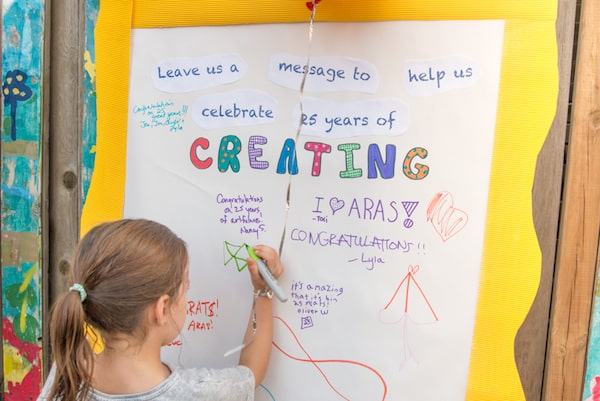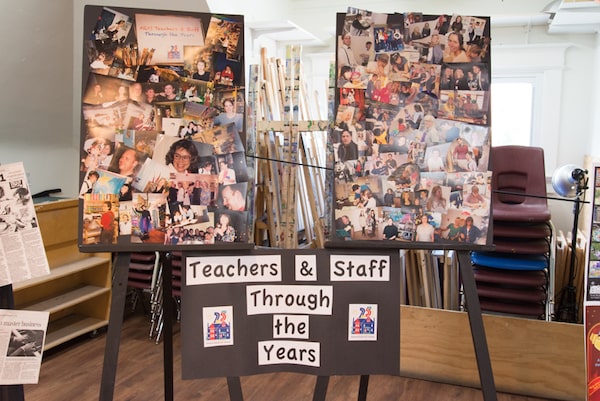
Classes range from toddler arts and comic book studies to digital photography, advanced ceramic sculpture and 'drawing for the terrified.'Jennifer Chin/Avenue Road Arts School
Other than the address, there’s nothing pretentious about the Avenue Road Arts School, an encouraging, non-judgmental and empowering place of learning that is more oasis than institution. Created in 1993 by someone with no formal training as a teacher, the Toronto school’s warmhearted asymmetrically is its chief charm and virtue.
“I had no idea what you were supposed to expect from a five-year-old, so I kept on pushing them,” says founder Lola Rasminsky, an Order of Canada recipient who first began holding after-school art classes for five paint-smeared children in her basement in 1979. “I found that people were surprised at what kids were able to do.”
Those same people were probably surprised at what Rasminsky could do with the Avenue Roads Arts School, a place that recently received a stuffy-sounding honour – the Canadian Business Excellence Award for Private Businesses – that belies its freestyle approach and the homey Victorian house where the schooling happens.
The institution serves preschoolers, kids, teens and adults who want to “unleash their imagination and have fun,” according to the brochure. This year some 800 students flowed through five studios, with classes held throughout the day and into the evening. Kids come before and after school; adults arrive any time. Classes range from toddler arts and comic book studies to digital photography, advanced ceramic sculpture and “drawing for the terrified.”
The one constant? The teachers are almost all working artists. “They have to be inspiring in their own right,” Rasminsky says. “And they have to be friendly and supportive. If they’re not, they can be the most qualified in their field, but this school is not where they belong.”
Rasminsky (whose father, Louis Rasminsky, was the governor of the Bank of Canada from 1961 to 1973) finds the range of adult students fascinating, particularly the ones involved in what she calls “left-brained” occupations – everyone from engineers to heart surgeons. Toronto painter Ann Wilson was a government lawyer before taking classes. And there’s a former accountant who now teaches drawing at the Ryerson School of Fashion.

Created in 1993 by someone with no formal training as a teacher, the Avenue Road Arts School’s warmhearted asymmetrically is its chief charm and virtue.Jennifer Chin/Avenue Road Arts School
On the right-brained side, Taylor Prize-winning author Plum Johnson took classes for years, even a writing course. You may know Gideon Arthurs as the chief executive of the National Theatre School of Canada, but he was a teacher and registrar at the school. Rob Binet, currently a choreographer with the National Ballet, developed his skill at shaping forms as a kid taking pottery classes.
One of the current students is actress and comedian Debra McGrath. Her relationship with the school began when she would drive her artistically gifted retiree father to school. “I would sit in the parking lot with my sandwich and tea, waiting to bring him home,” McGrath says. “I didn’t have the nerve to go in.”
After her father died, she gathered up her courage and his art supplies and ventured into the school. The experience has been a revelation.
“Growing up and going to the school in the 1950s, everything was precise,” says McGrath, 64. “We were told to colour inside the lines. But at this school, we’re told to go for it and to make mistakes. We’re encouraged to draw bold lines, and to either put the end result on the kitchen fridge or in the shredder."
What is great advice to novice landscape painters is also useful for living one’s life, whether to impressionable kids or never-too-late adults. The underlying theme to the instruction is one of empowerment: That as an artist, from finger painters to Picasso, one is calling their own shots.
“There are so many places in our life where we feel we’re not in control,” Rasminsky says. “When you take an art class, you’re the one making the choices. We need a place where we feel it’s all about us, where nobody is telling us what to do.”
 Brad Wheeler
Brad Wheeler